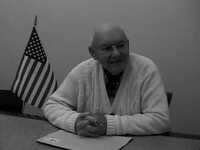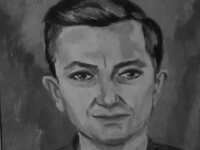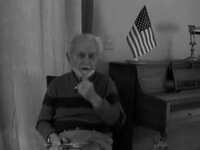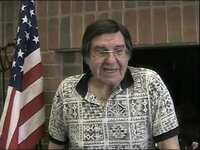Second World War - European Theater
Explore the Oral Histories from Ypsilanti area Veterans who served in the European Theatre
-

Koch, Owen R.
Owen enlisted in the Marine Corps, in January 1943, because he did not want to be drafted into the army. Joining him were three friends, who all wanted to serve together. The Marines could not guarantee this, and as it turned out, each one went into a different service (Army, Navy, Army Air Force, and Marines). After enlisting, Owen took the train to San Diego for boot camp, in May 1943. He was shipped out in February, 1944, to the Marshall Islands with the 2nd battalion, 4th marine division. His company was a “joint assault signal company” that was responsible for ship-to-shore communications. He was a telephone man, who carried the wire and switchboard to set up these points, mainly for the command posts. Though radio was more widely used, the telephone was also a way in which personnel communicated between posts or ship-to-shore. One problem that service members encountered often was that their own tanks would run over and damage previously laid wire. Owen was generally on the front lines in the command post. He often laid line and operated the switchboard during combat, including combat that involved machine gun fire. One thing that he remembers the most was when he landed on the beach in 1944 next to a marine, and as he turned to ask if he was ok, he noticed the man had been decapitated. That experience drove home the reality of war. Just after that, one of the American block houses blew up, and Owen was hit by burning shrapnel, so he was taken to the medical tent. There, he was bandaged, but he refused a purple heart because the man next to him had lost a leg, and Owen didn’t think it was fair to receive an award for his own small injury, in comparison to the other soldier. He landed at night on the island of Tinian, to set up a command post. He was on switchboard duty one night until 2:00, when he was relieved. He and two others dug a foxhole to sleep in. Within five minutes of the foxhole’s completion, an artillery shell hit the tree near them. The other two men were hit, and one was killed. The man that had taken Owen’s place at the switchboard had been killed as well. The tarp was only free of scarring where the man had been laying. Owen received a Presidential Unit Citation when the 4th division took Saipan. This unit would also later take Iwo Jima, but by that time he was in the hospital. In August 1944, he became ill, and went to army hospital. Owen had Ludwig’s Angina; an inflammation of the right mandible joint. He had to have a tracheotomy, and was in the hospital from October through March, during which time he had 144 shots of penicillin. Owen then went back to the rest camp on Maui. When he came back, he and others began training for the intended invasion of Japan. The plan was to land on the first Japanese island in March 1946. The plan was cancelled after the Japanese surrender. He returned in October and was discharged on November 19th 1945. After his discharge, Owen stayed with his mother. He met a girl in 1942, prior to his service, who worked in a restaurant on State Street in Ann Arbor. They wrote to each other during the war, and she was proud that he went. They got married in 1947, had 11 children together, and are still married today. Owen worked at an optical business after the war. He started as a messenger boy delivering glasses. Owen would later open his own business, called Quarry Optical, which later became Richardson’s optical. He sold the business in 1990, and retired. Owen believes that “once a marine, always a marine”, and is a member of the Marine Corps League of Washtenaw County. -
Karsten, Marvin
Marvin was drafted before he finished high school. After completing basic training in Illinois and Wyoming, he was sent to England on a converted liner. Some 8,000 GIs were on this ship, staked five high in bunks. Marvin was in the middle bunk. He stated that being with so many sick soldiers and in the middle bunk was quite the experience. In England, he was assigned to waterproofing supplies that were headed for Omaha Beach. Marvin remained in England until VE Day. While there, he was involved in guarding Polish prisoners of war, most of whom had been forced into service in the German Army. Eventually, Marvin was part of the Occupation Army in Germany. He was fortunate to get a pass to the Palace of Justice and witnessed Herman Gering's trial. After leaving the service, Marvin returned to Rogers City, where he began his career as a seaman on the Great Lakes, eventually working himself up to the rank of Master Captain. He retired after 32 years of sailing. -
Kaczorowski, Harry Francis
When Harry Kaczorowski was interviewed, he was 88 years old, a veteran of World War II and a POW of the same. Although his memory was a little sketchy, his daughter, Toni Oliveri, was able to supplement his memory. Harry was captured shortly after landing in North Africa. He spent 27 months in various prison camps. His memory focused on working on farms, and he said that he had enough food throughout his interment. Toni reminded him that while he was being interrogated, the Germans broke his collarbone and arm. As the war was winding down, the Germans continually moved prisoners, by foot, over a "600-mile death march." It was so cold that prisoners would wake up each other every 10 minutes, or they would freeze to death. Prior to being taken prisoner, Harry was on guard duty at the Allied Headquarters in Algiers. He irritated one General because he would not allow him to pass, since he did not recognize him. That General was George Patton. -
Jankoviak, Paul R.
After the United States entered World War II, Paul Jankoviak received deferments from the draft, because he held an essential job. He felt guilty about this and forced the Draft Board to take him. Soon after he entered military service, he volunteered for the paratroopers, and was shipped to Europe. Paul's Unit jumped into battle during Operation Market Garden from 500 feet. More than 500 planes participated, and Paul witnessed gliders crashing with men still inside them. After 85 days of continuous battles, his unit was transferred to the Battle of the Bulge. They were warned that the Germans were not taking prisoners, but Paul was captured. He was put on a truck that had American markings. German planes shot up the truck even though the people inside were being transported as prisoners. Paul received frequent beatings from the Germans. When he was finally released, the doctor told him he was one or two days from dying. He spent 6 months in hospitals. After his discharge, Paul took a job as a tool and die Maker. He is proudest of the fact that he built his own house and didn't borrow any money for it. Now retired, Paul lives in Lansing, Michigan. He has 6 children and 13 grandchildren. -
Ingling, Robert Bayer
Robert was inducted on February 8, 1944, after completing one year at the University of Michigan School of Engineering. He had been deferred once, but turned down a second deferment, because he wanted to be part of the war effort. Robert started out in the ASTP program which made him happy, because he thought that he could continue his education. After two weeks, he was headed for basic training at Fort Benning, Georgia, and was assigned to the 95th Infantry Division. The 95th was used as a replacement pool for other Divisions that had experienced large numbers of casualties. On August 9, 1944 Robert embarked for Liverpool on an unescorted ship, the USS West Point. Fortunately, the ship was too fast for the U-Boats. After three weeks in England, the 95th was sent to Omaha Beach, where it joined the 3rd Army under General George Patton. Robert’s outfit captured the major city of Metz, taking major casualties. He was then transferred to the 9th Army for the drive on the Rhine River. Although the worst fighting was over, "mopping up" operations took many lives. Robert returned to the United States for a thirty-day furlough, prior to being sent to amphibious training, for the planned invasion of Japan "Operation Coronet." The planned invasion was cancelled after the Japanese surrender. Of the original 44 men in his platoon, he was one of six who came through uninjured. Robert experienced the fear of combat, and he wondered if he would make it to see his parents again. Although not wounded, he did spend 27 months in hospitals because of service-connected TB. With service time, hospitalizations, and reduced workloads, it took Robert ten years to finish college. The 95th has had reunions since 1950, being deactivated right after the War, with diminishing numbers. Last year alone 99 members died. The morality of using the "bomb" stirred up much controversy, but Robert firmly believes that without it, he wouldn't be here today. -

Hunt, George
George S. Hunt was drafted into the Air Force. George entered the service at a time when the United States was very short on flying personnel. After an accelerated training program, George was sent to England. George and his crew flew several difficult missions. One involved a crash landing in England. When George was finally shot down, his plane was shot up so badly that the crew jumped out. George was captured and taken to a stalag, where he spent 14 months. Upon his discharge, George entered college and received his PhD from the University of Michigan in Wildlife. George became a Professor of Natural Resources and taught about birds, trees, and nature until his death in 1971. His history and experiences were relayed by his widow, Virginia Hunt. Although he lived only until the age of 51, he touched many lives and carried a message of being careful of our environment, and of making our land better for future generations. -
Hanson, Donald Mangus
Donald Hanson enlisted in the Navy in 1942. He was commissioned as an Ensign in November 1943. He spent WWII as a training officer. His training tasks included Flight Instruction, Jet Training, Gunnery Training, Photo Training, and Nuclear Weapons Employment. After the war, Donald completed his studies at the University of Minnesota. Most of his time in active duty was spent in Korea with the F9F Panther Jet. Hanson flew a total of 70 missions, 51 combat and 19 noncombat. After one of his missions, he landed his plane on an Aircraft Carrier and found over 300 holes in the plane from enemy fire. Hanson got his nickname because he liked flying low. During one training flight, he and two trainees flew under telephone wires. Although he was reprimanded, he felt he got off easy. From that time on, the other flyers called him "Hoppy." Hoppy retired in 1964 as a Navy Commander. He and his wife now live in Novi, Michigan, at Fox Run Residents. Both he and his wife have been very active in a variety of volunteer activities. -
Faes Jr., Frederick F.
Fred played instruments early in life, especially in school. He attended McKenzie High School, where he won a scholarship to the Detroit Institute of Technology. One of Fred's first jobs was playing in nightclubs. Early in World War II, Fred worked for Ford Motor Company and was not allowed to enlist because he was a required worker. Then, in August 1942, Fred was drafted and went to Ft. Custer for basic training. He was classified as a musician and posted with the 523rd Air Force Band, which was also known as the 23rd Army Air Force Band. The band was stationed at Camp Shanks, New York, and was on duty to play for the men boarding troop transport ships, bound for Europe and Africa. When his band was shipped out, no one was there to play for them. The ship that Fred was on went first to La Havre, to drop off infantry troops. The band disembarked with them, and then found out they were supposed to go to England. They had to re-board and continue on to Southampton. He spent most of the war playing at hospitals and dances, but very rarely played for big name entertainers. They generally brought their own bands. During his time in England, Fred had the opportunity to travel the country. He discussed the devastation of London and surrounding countryside, the shortages of everything, and the courage of the British people. He was based in Manchester at the Base Air Dept #2, which was an arming stop for incoming planes flown by WACs. He was on base the day of the Freckelton RAF accident, when an RAF pilot lost control of his plane, and it crashed on the base. Fred talked about an unspoken privilege system, which regular soldiers felt that the band members had. Fred's wife, Helen, was his high school sweetheart. She, along with his parents and siblings, wrote to him often. He remembers having to reply to letters by writing in the latrine, for light and quiet. Fred played the saxophone, trumpet, clarinet and flute. He came home from the war in 1945, and married Helen. Fred took a job teaching music at Dearborn's Salina Jr. High School, starting in 1950-51. He continued to teach there for 32 more years. Fred lost touch with most of his war-time friends but keeps a significant scrapbook of photos taken by others and him. -

Eliot, Marvin "Sonny"
After graduating from Wayne University (now Wayne State University) with both a bachelor's and Master of Arts degrees in Detroit, Michigan, Mr. Eliot enlisted in the United States Army Air Corps. Trained as a bomber pilot for the B-24 bomber, Eliot would be sent to England where he would fly bombing missions into Nazi-occupied Europe. Eliot was shot down by German forces, and would go on to serve 18 months as a POW. At some point the German soldiers of the installation he was assigned to became aware that Mr. Eliot was Jewish and was made to wear a star with the word "Juden" on it. Following his liberation by American forces, Eliot would return to Metro Detroit to serve as the long-time weatherman for WWJ. -

Elbert, Joseph
Mr. Elbert was drafted into the United States Army in 1944. After completing basic training, Mr. Elbert was sent to join Allied Forces fighting for control of the Italian Peninsula. After reaching Naples, Elbert was wounded by shrapnel fire coming from German soldiers fighting in Italy. He would later be awarded the Purple Heart for his service in Italy. -

Ditzhazy Sr., Joseph Andrew
Joseph is from Michigan and was in the Civilian Conservation Corps (CCC), in the Upper Peninsula. He was drafted in August 1943, but the army let him finish high school before he entered the service. Joseph was sent to Fort Benning for training when he was around 20 years old. He had only 13 weeks of training before going to school at the University of Wisconsin-Madison and was there for several weeks of engineering training. Joseph failed on purpose, so that he would be able to join the army immediately, rather than after college training. He joined the 104th Howling Timberwolves at Camp Carson, in Colorado, for training until they went overseas. They trained at night and were known as “Night-Fighters.” Joseph only fought in one daylight battle while overseas. He landed in Normandy 3 months after D-Day (D-Day+90). The 104th moved through France and into Belgium. Three days later, they received orders to get ready to fight in Holland, where they fought to free the port of Antwerp. Next, the 104th crossed into Germany over the Roer/Rur River to Aachen, to assist the 1st division. Joseph was in a mortar battalion, and was a squad leader, although he was never formally recognized as such. Another squad leader didn’t like him and denied knowing him when asked. Joseph’s unit spent 195 days in constant combat with Germans. This combat took place from Holland down to Aachen, and until the war’s end. He only fought 120 of the days, because he was wounded. Shrapnel from a shell hit him, and he lay for eight hours, waiting for rescue. He was put on a train to Paris, and then to England. He woke up in a hospital in Oxford. He stayed there for three months while he recovered. He was finally sent back to the States, and he arrived in southern California, where he was discharged. After his discharge in 1946, he attended Michigan State University, and worked for GM and Chrysler, as a quality control manager. His unit, the 104th, has had a reunion every labor-day weekend since 1946. -
Deal, Herman A.
Herman Deal was born in rural Georgia, in 1923. After completing high school, he took a job building ships. After a year, Herman and his buddies enlisted in the Air Corps, because they were promised that they would be together there. That lasted only a few weeks before they were separated in different training programs. His training took him to Boston, Texas, and the Willow Run plant in Michigan where the B-24s were built. This is where he met his future wife, Helen. Herman learned everything there was to learn about the B-24, including how to pilot the plane. He became the third (emergency) pilot of one. Herman's plane was shot down by very heavy flak on his first mission, to attack a submarine base at Toulon. After he was captured, Herman occupied himself with useful activities, including attending classes, for which he eventually received 18 college credits. Herman's camp was in Austria, but when the Russians began getting close, the entire camp population marched through Germany to Lenz, in the so-called 600-mile death march. His group was finally liberated by the 3rd Armored Division, in Patton's group. After returning to civilian life, Herman became involved in several successful businesses. Today, he and his wife of more than sixty years live in Ann Arbor. Although he is "retired," he works every day. Herman has been honored as one of 21 successful business people in Ann Arbor.

